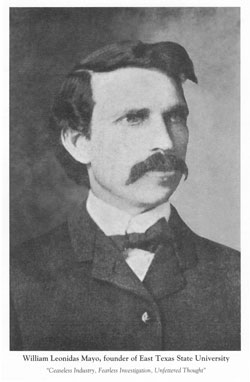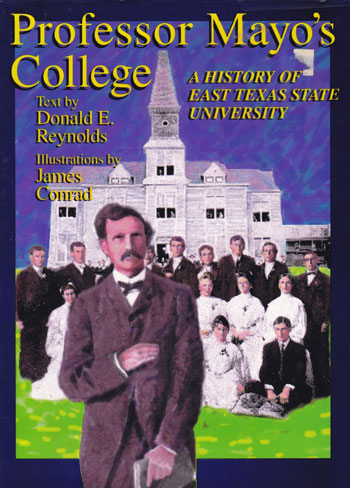
“Ceaseless Industry, Fearless Investigation, Unfettered Thought”
Photo and motto compliments of Archives in Gee Library, Texas A&M University – Commerce
Recently a gentleman who follows my daily Facebook page asked a very good question. Why does the college located in Commerce, Texas, have so many different names in its past? And the answer is fairly simple unless you are a real traditionalist.
In September 1889 William Leonidas Mayo opened a school up the road from Commerce in the little town of Cooper. Not only were elementary and secondary students admitted, Mayo, who owned to college and its building, created a “first-class private college” based on Normal principles. This was a new way to educate teachers, not by rote, but by practice.
Cooper seemed to be the perfect place for Professor Mayo. He met the lovely, talented and outspoken advocate of women’s rights. He married Henrietta “Etta” Booth while she was visiting family in Cooper. However, there was a slight deficiency in locating in Cooper. No railroad came through the small town; railroads were vital to the success of such a school.
A fire destroyed Mayo’s school and offered a reason to relocate. The community of Commerce was very enthusiastic in getting a Normal College. The townspeople gave a plot of land and $5,000 to start East Texas Normal College. By 1895 the new college was in place.
For many years Texas school teachers were required to attend “Normal Schools” each summer to obtain and retain their teaching certificates. East Texas became the best attended Summer Normal for many, many years in the entire state.
Fire again destroyed College Hall with its science lab and 5,000 book library in 1907. Four years later three dorms were destroyed; no once was injured or killed. Commerce citizens opened their homes to students while 650 alumni raised more than $30,00 to rebuild.
In 1917 the most important event in the school’s history occurred when State Senator Edwin Westbrook of nearby Wolfe City pushed a bill through the Texas Legislature to add East Texas Normal College to the list of state supported schools. Again, the name changed to East Texas State Normal College. Unfortunately, Professor Mayo died before learning the great news.
Randolph B. Binnion was chosen to lead the college to greater heights. Students competed in four sports, football, basketball, track and women’s basketball. When the state refused to fund housing for students, Dr. Binnion successfully found the funds and convinced the state that housing was vital to rural students.
Another name change came in 1923 when it became East Texas State Teachers College. In 1925 Dr. Samuel Whitley took charge of the college. He and his family were the first to reside in the President’s Home. He deftly dealt with the Great Depression, by using New Deal programs, such as NYA or National Youth Administration. He led the college through World War II but died suddenly from a heart attack in 1946.

Arthur Clinton Ferguson, as interim president, handled the GI bill, and need for housing. In 1947 Dr. James Gilliam Gee became the next president. During his term the word “teachers” was dropped from the name and “college” became University as in East Texas State University (ETSU) when the first doctoral program appeared on the scene.
In 1964 ETSU quietly integrated before many of the local public schools did. Finally, in 1996, after much discussion, the words “East” and “Texas” were removed from the 110-year-old institution. Today it is Texas A&M University-Commerce. Under the A&M System, the university continues to grow. For more information go to www.tamuc.edu/aboutus/. In 1993 Dr. Donald Reynolds and Dr. James Conrad published an excellent history of the university, Professor Mayo’s College: A History of East Texas State University.
